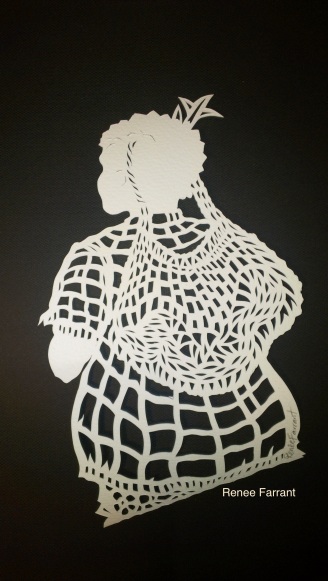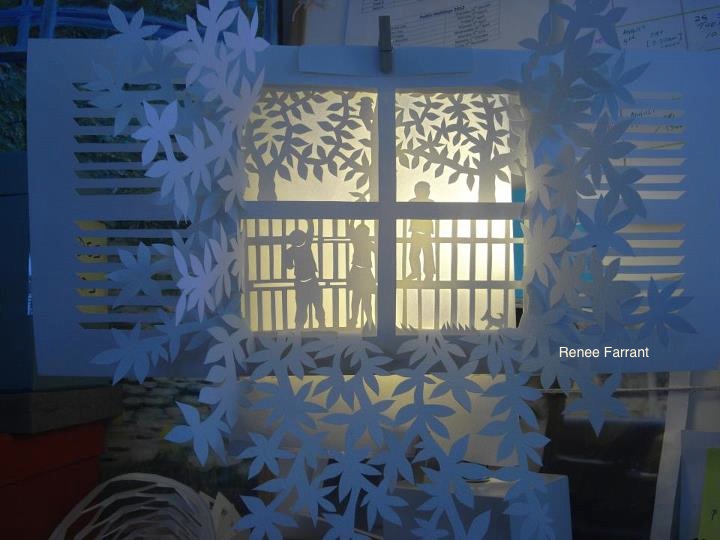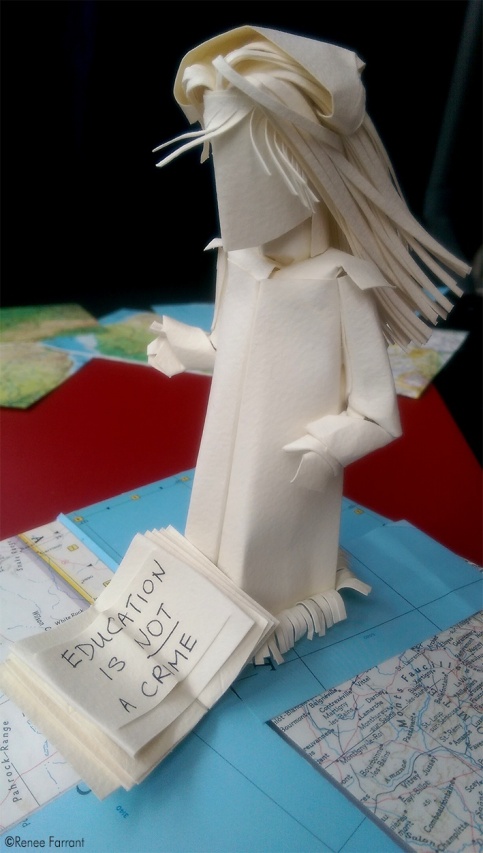
Today’s special guest is Renee Farrant, a paper sculptor.
Renee Farrant’s art practice solely utilises paper, relying on self-taught hand cutting and paper-folding techniques.
Working full-time from her studio outside Albany (WA), her preference for the paper-medium stems from an interest to create artistic expressions from everyday materials.
Farrant believes that art has an important social responsibility. As her art practice lends a hand to community building projects, paper is an excellent medium for making art with little means.
Farrant’s experimental approach to paper art allows her practice to evolve and to be applied in diverse settings, from public art to music video.
Follow Renee on facebook Renee Farrant Art
June: Renee – what led you to work with paper sculptures?
Renee: The desire to develop my practice and the love of sculptures created the impetus to evolve from 2-dimensional to 3-dimensional works.
My paper-sculptures require intricate hand-cutting and working with sharp tools, which I can only attribute to influences from south pacific oceanic art. My parents can attest to my early love of trawling through craft markets, PNG Arts warehouses and the National Museum in Port Moresby, Papua New Guinea.
When working with paper, it is difficult not to draw inspiration from the art of origami. The process of transforming the flat-paper medium into a constructed form is always magical!

June: What are the challenges and advantages of working in these media?
Renee: Ha!Ha!Ha! I will try to be brief
One of the challenges is the commitment of labour-intensive hours. Preparing for an exhibition involves a long-lead timeline, self-discipline and many re-heating of cups of tea. My practice is only possible because I have the support of my amazing family and husband!
Another challenge is sourcing my paper as I am very selective about the quality of the paper. The paper I am currently using comes all the way from the UK in a 10 meter roll. Then there is the challenge of transporting the roll of paper to my studio, which is nestled within Torndirrup National Park in regional Western Australia.
The lovely advantage of working with paper is the cleaning-up. No splatters. No fumes. The only spills are from that neglected cup of coffee.
June: What are the main inspirations with your work (discuss a couple of examples)? (Tell me about any other paper artists and you can mention about spiritual inspirations such as – the paper cut for Tahirih?)
Renee: Reflecting on your question, I feel that works are inspired by story boards. Artisans along the mighty Sepik River (in Papua New Guinea) engrave their stories on panels of wood. The story boards would depict their village occupation, life, flora and fauna.
The contents of my works are inspired by stories and events concerning humanity. For example, for an exhibition entitled ‘Journeys of the Intrepid Woman’ (2012, ArtGeo, Western Australia), I was very privileged to present a series of works informed by the true story of Tahirih the Pure (1817 – 1847 approx). The first woman suffrage martyr was not from the West, but this young woman from Qazvin, Persia (today, Iran). Tahirih’s courageous life inspires millions of people today.

Being a Bahá’í also provides the further catalyst to grow my skills. The Bahá’í Writings allude to the central role of artists in society, stating that “…the true worth of artists and craftsmen should be appreciated, for they advance the affairs of mankind.”
Wow!!! what a profound role of the arts!!
Note: the quote is by Bahá’u’lláh (1817-1892), from a tablet translated from the Persian, cited in “Extracts from the Writings Concerning Arts and Crafts,” in The Compilation of Compilations, Vol.1, Mona Vale: Bahá’í Publications Australia, 1991, p. 1.]
June: Can you tell me a bit more about the one you did on the Papua New Guinean lady with the string bag on her head (I think)
Renee: The “lady with a bilum” work expresses my gratitute to the wonderful people and communities of Papua New Guinea. My teenage years (1980‘s) were spent in Port Moresby where my parents were working as educators. I feel that the Papua New Guinean community was like my spiritual mother; her nurturing and love played a profound role in those formative years.
A ‘bilum’ is a Papua New Guinean string bag, traditionally woven from natural string fibres, sometimes incorporating possum-hair. Bilums are used to carry sleeping children and food crops.
June: What has been the highlight of your arts practice and career?
Renee: The highlight of my art practice is when I was able to collaborate with other makers and creators.
The below are my growth-&-soul feeding events:
- Working with Dr Marjorie Tidman and Naysan Faizi on Marjorie’s book cover for ‘Sifting The Dust – God and the Mad Psychologist’;
- Working with Shameem Taheri-Lee and Jason Eshragian on the Under One Sun music video;
- Prop-making for Delia Olam’s play at the 2015 Adelaide Fringe Festival. Note: Delia will be performing at the Edinburgh 2016 Fringe Festival.

Follow Renee on facebook Renee Farrant Art She is happy to consider commissions for paper cut cover art.
Thanks so much Renee for dropping by the blog and sharing your thoughts and practice on just how profound art can be.
C’est magnifique…
Les détails sont infinis… les oeuvres sont délicates et émouvantes.
LikeLiked by 1 person
These paper sculptures are awesome. Thank you for sharing Renee’s work. I am in awe of what can be created from paper – so intricate and beautiful.
LikeLiked by 1 person
I love your work! Very talented indeed!
LikeLiked by 1 person
I’ve let Renee know of your comment and she may be over later to leave a reply Leroy.
LikeLiked by 1 person
Yes, I really love this work Norah. Glad you were able to stop by.
LikeLiked by 1 person
Merci! MyoPaname
LikeLiked by 1 person
Merci beaucoup pour vos paroles d’encouragement, MyoPaname. Veuillez rester en contact sur ma page Facebook ” Renee Farrant Art”.
LikeLike
Norah, Leroy, Thank you very much for your words of encouragement. Please stay in touch on my Facebook page ‘Renee Farrant Art’.
LikeLike